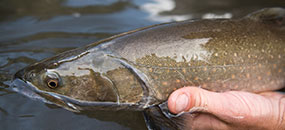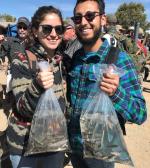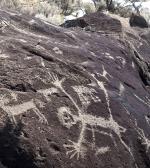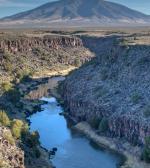By Randy Scholfield
There are powerful places that ground us in reality—that literally put us in our places.
They’re touchstones that inspire wonder and provide solitude and challenge limits. They vanquish hubris and small thinking and put things in larger perspective.
The Rio Grande River gorge in northern New Mexico is one of those grounding places for me.
New Mexico was one of the first places I visited out West when I was a teenager from the Kansas flatlands driving in search of adventure. It felt like another world of vast possibilities and freedom. Even today, this high desert landscape rekindles those youthful feelings whenever I visit.
One place I keep returning to is the Wild Rivers area of the Rio Grande gorge—it has a powerful pull. I first came here to fish maybe 25 years ago.
Stranding on the canyon rim, you can barely see the ribbon of river below. It’s about a mile down on steep rocky switchbacks. As you hike down along the walled trail that clings to the canyon face, the river sounds sneak up on you, the whisper of waters growing louder and more urgent.
When you reach the bottom, you’ve entered another world. The river is there, a powerful rushing presence contained within the soaring canyon walls. A crow flies overhead. The silence is overwhelming. You can fish there all day, scrambling over huge volcanic basalt boulders –some as large as houses—and never see another person.
There are big rainbows and browns in these waters. As well as pike and warm water species like bass and carp in stretches. No, the fishing is never dependable. It’s a fickle river, depending on the ever-changing flows and clarity. A thunderstorm upstream can quickly turn the river muddy and turn off the fishing. But that unpredictability is also part of the appeal and part of the bargain.
This canyon has a strong presence, at times strange and slightly spooky. You lose sense of time, engulfed in this place. There are petroglyphs and signs of ancient human habitation down here. There are rattlesnakes.
This is a river that has sustained humans and wildlife for a long, long time.
When the shadows grow long on the canyon wall and light fades, I’ll break down my rod and start hiking back up. It’s a bit of a lung-buster, and stopping on the switchback turns to catch your breath provides some parting glimpses of the vistas below. Nearing the top, the river shrinks to a muted ribbon again, but you still feel it in your bones.
In 2013, this vast landscape was protected as the Rio Grande del Norte National Monument—a designation strongly supported by local communities such Questa that depend on recreation dollars.
As I write this, the administration has issued an unprecedented executive order to review many of the West’s national monuments, including the Rio Grande del Norte, to determine whether they deserve designation. They’re considering delisting or scaling back some of the monuments.
It’s a shortsighted political stunt.
I won’t rehearse here how these monumental places have economic value and cultural value and “pay their way,” although that’s important. See this recent report about how monuments benefit local communities.
There is also value in having these special places that renew us with their grandeur and solitude and open spaces.
We are here in fleeting moments. Shadows on the land. The great river goes on forever. It’s good for the soul to visit these places and be reminded of that from time to time.
Please, take a moment and tell our leaders that you care about protecting our monuments.
Randy Scholfield is TU’s communications director for the Southwest.








